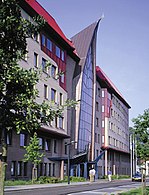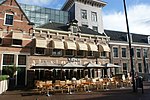De Museumfabriek
Commons category link is locally definedEuropean Route of Industrial Heritage Anchor PointsIndustry museums in the NetherlandsTextile museums in the NetherlandsTwente

De Museumfabriek (formerly Jannink Museum of Textiles and Social Life and TwentseWelle) is a museum in Enschede, Netherlands. The new museum is located partly in a renovated Jannink textile factory, in reference to Enschede's textile history, and partly in an adjourning new building designed by the Amsterdam-based firm SeARCH. The project architect was Bjarne Mastenbroek. It is an Anchor point on the European Route of Industrial Heritage.
Excerpt from the Wikipedia article De Museumfabriek (License: CC BY-SA 3.0, Authors, Images).De Museumfabriek
Moutlaan, Enschede
Geographical coordinates (GPS) Address Nearby Places Show on map
Geographical coordinates (GPS)
| Latitude | Longitude |
|---|---|
| N 52.2323 ° | E 6.891 ° |
Address
Moutlaan
7523 MD Enschede
Overijssel, Netherlands
Open on Google Maps








